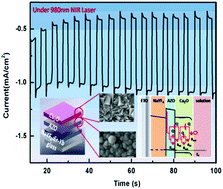The fabrication of a photo-carrier transfer channel for a near infrared up-conversion coupled photocathode via a sandwich-like nanostructure†
Abstract
Near infrared (NIR) energy up-conversion (UC) is an important topic related to sustainable energy harvesting. In NIR UC devices, decreasing the transfer impedance of the photocarrier is an urgent challenge. In this work, we fabricate a NaYF4:Er3+–Yb3+/AZO/Cu2O sandwich-like photocathode device. In this structure, the Al-doped ZnO polycrystal thin film (AZO) interlayer acts as a functional channel for photocarrier transfer and back collection, which can reduce the impedance when photocarriers pass through the NaYF4 layer in a traditional NIR-UC coupled photoelectrode. The AZO layer also acts as a buffer layer to decrease the lattice mismatch at the NaYF4:Er3+–Yb3+ and Cu2O interface, resulting in a lower density of interface defects and higher crystallinity of the Cu2O thin film. Based on the dual functions of the AZO interlayer, this NIR-UC coupled photocathode achieved a recorded photocurrent density of 1.0 mA cm−2 under 980 nm laser (1.0 W cm−2) illumination. Therefore, this is a promising strategy to solve the main issue of very high photocarrier transfer impedance in NIR-UC coupled photoelectrodes.



 Please wait while we load your content...
Please wait while we load your content...